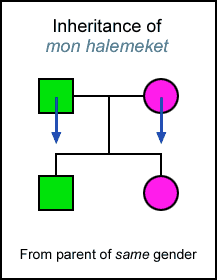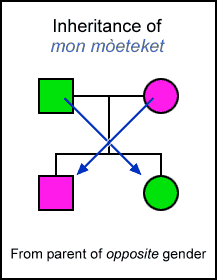As is common with many human and human-varient cultures, Zurvár tend to organise themselves into family units of two monogamous parents and their offspring. This page details some of the cultural and linguistic consequences of this system.
Partnerships
The basic family unit in Zurvár culture is the vitelá or "Partnership". This embraces aspects of both the traditional marriage and more casual "de-facto" relationships of western Earth society.
A Partnership consists of two adults living in a committed, monogamous relationship. Except where circumstances prevent they should live under the same roof, it would be considered extremely strange for supposed mon vitelik to live separately. Strictly speaking (or traditionaly at least) a vitelá consists of a man and woman, not same-sex couples, although Zurvár culture is remarkably non-hung up about issues of sexual preference and all but a few fanatics and prudes find same-sex Partnerships perfectly acceptable.
A Zurvár can engage in a Partnership as soon as they reach partial adulthood (the age of 16). It is unusual however for a couple to Partner this early as mon vitelik are expected to move into a home of their own, something that few 16 year olds can afford. It is more usual for a couple to wait until they can support themselves, which is generally closer to the age of full adulthood (25). Often a couple will declare a bemarqár or "intention" to Partner, and then wait until they are economically independent. This can sometimes take years, however Zurvár society places no taboo on sexual relations between non-Partnered adults so this usually causes few problems. Traditionally no token is exchanged between bemarqurn couples, however in recent times (influenced by engagement practices on Earth) it has become somewhat fashionable to give each other a piece of jewelery such as a ring or necklace.
There are considered three ways to become Partnered. The simplest is for a couple to just move in together. After three months of co-habiting they are considered to be Partnered and have all the legal rights and priveliges of mon vitelik. Traditionaly this was the only option available to same-sex partners, although this is changing in some cities.
The second method is slightly more formal. The couple announce their intention to be partnered to the community, wait for two weeks, then move in together. Traditionally (when Zurvár lived in relatively small towns and villages) the announcement would take place at a community gathering of some sort such as a town meeting or the annual lacè. In the large cities it's now standard to announce the intention personally to friends and family then place a notice in the local sûlnárádom. Often a party (analagous to an Earth "engagament party") is held which features a formal anouncement. Two weeks later the couple move in together.
Traditionaly the two week waiting period was to give time for anyone in the community who disaproved of the vitelá to speak up, similarly to the "speak now or forever hold your peace" clause in Earth's traditional Christian marriage service. Nowadays it tends to be observed just because that's the way it's always done.
The final and most formal option involves an actual Partnering Ceremony, a sèená vitelá. This requires the announcement and two week waiting period described above, but prior to moving in together the couple must appear before the community and restate their intention before the mon šurit or "Elders". Traditionally the Elders are the oldest available members of the couple's mon mòet although nowdays it's not unusual for a local official (such as the goranet or Konsâtèum representative) to stand in. This is usually an oportunity for the couple to make a public declaration of their affection for and commitment to each other, a process somewhat similar to the "exchanging of vows" at an Earth wedding. The "vows" recited are typically written by the couple themselves, although they usually follow some well known examples.
The couple's families must then state their acceptance of the vitelá, followed by the community in general, and finally the Elders. If all three groups accept the vitelá it is declared official and the couple can move in together. This is usually a formality, it would be highly unusual for the process to progress to the stage of a sèená vitelá if the families, Community or Elders didn't approve.
A vitelá can be officially ended by one of the Partners moving out, and publicly declaring that it's over. While this is all that's actually required, a "seperation ceremony" or sèená árkátelá can be called by either of the Partners. This consists of a formal statement of the ending of the partnership and the reasons behind it before the community. If one of the Partners is unwilling to end the vitelá, they then have the opportunity to publically plead their case - although if things have got to the stage of a sèená árkátelá this rarely has any effect. A sèená árkátelá can be every bit as amicable or hostile as any divorce proceeding on Earth.
Once a vitelá is dissolved (either by árkátelá or the death of one of the partners) the partners are prohibited from forming a new vitelá for a period of three months. There is nothing to actually stop anyone from immediately moving in with someone else, but this is considered somewhat scandalous and in very poor taste by even the most liberal Zurvár. It is more acceptable to announce a bemarqár during this period, and then move in together two weeks after the three month period is up.
There is no limit to the number of mon vitelá a Zurvár may engage in during their lifetime, although someone who constantly hops in and out of Partnerships may develop just as bad a reputation any any serial monogomist on Earth.
Names
All Zurvár have three names. A personal name (or sàeket) which is given to them by their parents at birth, a family name (halemeket) and a house name (mòeteket), both of which are inherited from their parents. To respectfully address or introduce a Zurvár all three names should be used.
Personal Names
There are hundreds, if not thousands, of possible personal names. Some are traditional, some have been adopted from other languages and cultures, and some are made up on the spot. Traditional names generally have a meaning but knowledge of these is not widespread, names are generally chosen to honour a relative, friend or public figure, or simply because the parents like the sound.
Almost all names are either masculine or feminine. Newly coined or newly adopted foreign names may end up being applied to either male or female children, but generally a name will only be considered suitable for a boy or girl. As a rule male names cannot end with a vowel. When adopting male names from other languages it is usual to add either n, m or l to a final vowel.
While a list of all recorded personal names would be exhausting both to compile and read, the following table provides a few examples to give a 'flavour' of Zurvár naming practises.
| Feminine | Masculine |
|---|---|
| Aburàn, Anèkò, Cáná, Cakè, Câdùn, Câcà, Eren, Kerin, Màv, Mirandá, Námè, Nèkò, Pàc, Rakel, Rebek, Rèn, Sabrá, Será, Tazmà, Yûrès | Adam, Àeksùl, Aran, Ertùn, Godek, Hal, Caklan, Ludum, Mak, Malik, Mikel, Mòdek, Šamaš, Sâdak, Tádan, Câc, Cefrèm, Skot, Šarèf |
Family Names

Family names - mon halemeket - are passed from parent to child similarly to surnames in Earth's western cultures. Rather than only one name (or some kind of hyphenated name) being inherited however, a child inherits their halemeket from their parent of the same gender. For example if Dàná Šagathá Halevelárvá (Dàná Šagathá of house Halevel) and Aran Biritan Maqamikavik (Aran Biritan of house Maqamik) had a daughter, her halemeket would be Šagathá, after her mother. If they had a son his halemeket would be Biritan. A Zurvár's halemeket remains fixed throughout their life, it is not changed when entering a partnership.
Mon halemeket generally have meanings, although they are rarely considered on a day to day basis and can sometimes be fairly obscure. Biritan for instance originally meant "sailmaker", although most Zurvár wouldn't think about sails when using it any more than a native English speaker would think about bread when talking to someone named Baker. Many Zurvár, mostly those with particularly old mon halemeket are completely unaware of any meaning, and never even think about it.
House Names

The third name held by a Zurvár is the mòeteket or "house name". Every Zurvár belongs to an ancestoral House or mòet. In the past when the majority of Zurvár were nomadic, a mòet consisted of a loosely associated group of families travelling together and owing allegience to a particular Kanár or feudal lord. The halemeket of the Kanár was adopted by their followers to indicate their allegience and became their mòet.
Nowdays the mòeteket is preserved, but there is no fuedal obligation involved - apart from a general low-level comaraderie felt towards members of the same mòet, analagous perhaps to that felt between strangers who support the same sports team. Changes in the way the mòeteket is inherited over the last 400 years have largely contributed to this breakdown of the old system.
Originally a woman entering into a partnership became a member of her partner's mòet and any children were also members. With increasing gender equality in Zurvár society over the last few centuries this system altered to become parallel with the inheritence of mon halemeket. Nowdays mon mòeteket are inherited from the parent of the opposite gender. So to continue the example above if Dàná Šagathá Halevelárvá (Dàná Šagathá of house Halevel) and Aran Biritan Maqamikavik (Aran Biritan of house Maqamik) had a daughter, her mòet would be Maqamik and her mòeteket would be Maqamikárvá after her father. If they had a son his mòet would be Halevel and his mòeteket would be Halevelavik after his mother.
The way that mon mòeteket are constructed is worthy of note. The personal name is a special form of the mòet name, created by a suffix meaning (more or less) "member of", and indicating the gender of the Zurvar. The female suffix is -árvá, a female member of House Fèelis for instance would have the house name Fèelisárvá. The male suffix is -avik, a male member of House Fèelis would have the house name Fèelisavik
Over the last 20 years a gender neutral suffix has come into use -arvek. This is decried by language purists, but is gaining some currency, particularly among younger Zurvár. It was recently approved for official use in Gorat Kalif and Gorat Miam, and it is thought likely that the rest of the cities will follow suit within the next few years.
The mòeteket retains at least one culturally significant aspect - it is considered unusual and somewhat distasteful for Zurvár of the same mòet to enter into a relationship. Also worthy of note is the term vemòet or "double housed". This refers to a Zurvár who's mòeteket is the same as their halemeket - an almost certain indication of membership of one of the old fuedal ruling families. Although once a title of respect, vemòet today generally has a sense of haughtiness or pomposity about it, and is often used as a term of derision for someone who acts in a self important fashion, regardless of their names.